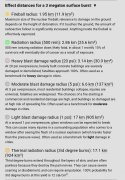Yeah. Needs many more years of refinement to get it down.If it's nuke does it matter if the target missed by miles? 2 dozen still huge tho.
You are using an out of date browser. It may not display this or other websites correctly.
You should upgrade or use an alternative browser.
You should upgrade or use an alternative browser.
China Ballistic Missiles and Nuclear Arms Thread
- Thread starter peace_lover
- Start date
- Status
- Not open for further replies.
Also maybe it doesn't include various precision instruments (advanced gyroscope, etc) because the purpose of the demonstration is to specifically evaluate the feasibility of the gliding vehicles.Yeah. Needs many more years of refinement to get it down.
The anglos have made no secret of their desire for a FOBS, this desire dates back to the Project For A New American Century days of the 90s and calling China's HGV test a FOBS is them trying to squeeze more taxpayer monies into their 'star wars' projects.
However, if any nation can do it effectively and at cost, it would be China.
EDIT: it sounds like China now has its own Avangard system
Okay I've gathered my thoughts:
1. DF-17 or at least the DF-ZF part of it has been tested plenty of times. I don't think it would kick up this much of a stink if it was just another straight DF-17 test launch, this must be something new
2. There's been plenty of rumours about PLARF wanting DF-ZF or something like it on top of a longer range booster. The one I've heard is DF-27, which is a DF-ZF on top of a DF-26 booster. Hell the North Korean Hwasong-8 which they tested recently seems to be a DF-ZF type HGV on top of the booster of their Hwasong-12 IRBM, so this line of thinking seems pretty obvious.
3. "goes into space and traverses the globe in an orbital-like fashion before making its run through the atmosphere toward its target" suggests a FOBS with the HGV as payload, where HGV is placed into LEO then deorbits for attack. I'm not entirely convinced this is what's happening. Qian Xuesen famously drew this diagram to explain his trajectory (of which DF-ZF is based on):

Note after reaching apogee and re-entering the upper atmosphere the vehicle maintains level flight all the way till it reaches the target. This is distinct from the skip-reentry trajectory proposed by Eugen Sänger which the vehicle performs multiple "skips" off the upper atmosphere. This flat part of the vehicles flight through the upper atmosphere looks like its in orbit but its actually not, its fighting gravity drag with lift and trading off velocity in the process. To me this matches the "orbital-like fashion" of the test's description.
So this test could be a DF-17 style HGV boosted by a larger booster stage than DF-17. Because of the higher initial kinetic energy imparted into the vehicle it may have allowed it to achieve a very long Qian Xuesen trajectory glide of several thousand kilometres.
Alternatively they could also be right, and this test is both a true FOBS as well as a HGV with a very long glide range.
1. DF-17 or at least the DF-ZF part of it has been tested plenty of times. I don't think it would kick up this much of a stink if it was just another straight DF-17 test launch, this must be something new
2. There's been plenty of rumours about PLARF wanting DF-ZF or something like it on top of a longer range booster. The one I've heard is DF-27, which is a DF-ZF on top of a DF-26 booster. Hell the North Korean Hwasong-8 which they tested recently seems to be a DF-ZF type HGV on top of the booster of their Hwasong-12 IRBM, so this line of thinking seems pretty obvious.
3. "goes into space and traverses the globe in an orbital-like fashion before making its run through the atmosphere toward its target" suggests a FOBS with the HGV as payload, where HGV is placed into LEO then deorbits for attack. I'm not entirely convinced this is what's happening. Qian Xuesen famously drew this diagram to explain his trajectory (of which DF-ZF is based on):

Note after reaching apogee and re-entering the upper atmosphere the vehicle maintains level flight all the way till it reaches the target. This is distinct from the skip-reentry trajectory proposed by Eugen Sänger which the vehicle performs multiple "skips" off the upper atmosphere. This flat part of the vehicles flight through the upper atmosphere looks like its in orbit but its actually not, its fighting gravity drag with lift and trading off velocity in the process. To me this matches the "orbital-like fashion" of the test's description.
So this test could be a DF-17 style HGV boosted by a larger booster stage than DF-17. Because of the higher initial kinetic energy imparted into the vehicle it may have allowed it to achieve a very long Qian Xuesen trajectory glide of several thousand kilometres.
Alternatively they could also be right, and this test is both a true FOBS as well as a HGV with a very long glide range.
I think the way to go would be keeping the HGV in an orbital trajectory for as long as possible and then dive and manoeuvre as it enters defended zones. The reason is that interacting with the atmosphere to generate lift will inevitably generate drag, which will decelerate the vehicle.Okay I've gathered my thoughts:
1. DF-17 or at least the DF-ZF part of it has been tested plenty of times. I don't think it would kick up this much of a stink if it was just another straight DF-17 test launch, this must be something new
2. There's been plenty of rumours about PLARF wanting DF-ZF or something like it on top of a longer range booster. The one I've heard is DF-27, which is a DF-ZF on top of a DF-26 booster. Hell the North Korean Hwasong-8 which they tested recently seems to be a DF-ZF type HGV on top of the booster of their Hwasong-12 IRBM, so this line of thinking seems pretty obvious.
3. "goes into space and traverses the globe in an orbital-like fashion before making its run through the atmosphere toward its target" suggests a FOBS with the HGV as payload, where HGV is placed into LEO then deorbits for attack. I'm not entirely convinced this is what's happening. Qian Xuesen famously drew this diagram to explain his trajectory (of which DF-ZF is based on):
View attachment 78267
Note after reaching apogee and re-entering the upper atmosphere the vehicle maintains level flight all the way till it reaches the target. This is distinct from the skip-reentry trajectory proposed by Eugen Sänger which the vehicle performs multiple "skips" off the upper atmosphere. This flat part of the vehicles flight through the upper atmosphere looks like its in orbit but its actually not, its fighting gravity drag with lift and trading off velocity in the process. To me this matches the "orbital-like fashion" of the test's description.
So this test could be a DF-17 style HGV boosted by a larger booster stage than DF-17. Because of the higher initial kinetic energy imparted into the vehicle it may have allowed it to achieve a very long Qian Xuesen trajectory glide of several thousand kilometres.
Alternatively they could also be right, and this test is both a true FOBS as well as a HGV with a very long glide range.
I also fail to see the advantage of the Qian trajectory vs the Sanger one. The vehicle doesn't need to manoeuvre throughout its flight and the greater drag might slow the vehicle to a point where terminal interception becomes feasible.
When the vehicle is gliding through the upper atmosphere it cannot be engage by exoatmospheric interceptors like SM-3I think the way to go would be keeping the HGV in an orbital trajectory for as long as possible and then dive and manoeuvre as it enters defended zones. The reason is that interacting with the atmosphere to generate lift will inevitably generate drag, which will decelerate the vehicle.
I also fail to see the advantage of the Qian trajectory vs the Sanger one. The vehicle doesn't need to manoeuvre throughout its flight and the greater drag might slow the vehicle to a point where terminal interception becomes feasible.
Selected a DF-5 + a nuclear warhead with a 3 Mt yield:If it's nuke does it matter if the target missed by miles? 2 dozen still huge tho.
1.95 km radius of vaporizing everything
3.14km radius of heavy blast damage
Based om that data, lets say that for military purposes (targeting structures), margin of error could be 2.5 km. So from 2 dozen miles down to 2.5km is not that hard for missile development, it just needs more time to refine the tech

escobar
Brigadier
"An over-designed missile with both glider and FOBS capabilities could be the PLA’s way of staying ahead of diversifying, improving defense systems."
Last edited:
Hendrik_2000
Lieutenant General
This guy Pollack is numb nut He said why put in the orbit it defeat the unpredictability of hypersonic warhead. Well because now China can send the missile to the south pole and avoid all the ABM site which are mostly geared toward the missile coming from the north pole as that is the closest distance from Asia to CONUS.. Those sites are located in Alaska and California.
In other word the missile can come from unpredicted vector
But coming from the south and east it will complicated the ABM Or they will force to spend enormous money to guard all the possible approach of the missile. It will bankrupt the country
But he later realized his ignorance and wrote this
In other word the missile can come from unpredicted vector
But coming from the south and east it will complicated the ABM Or they will force to spend enormous money to guard all the possible approach of the missile. It will bankrupt the country
But he later realized his ignorance and wrote this
Last edited:
- Status
- Not open for further replies.
